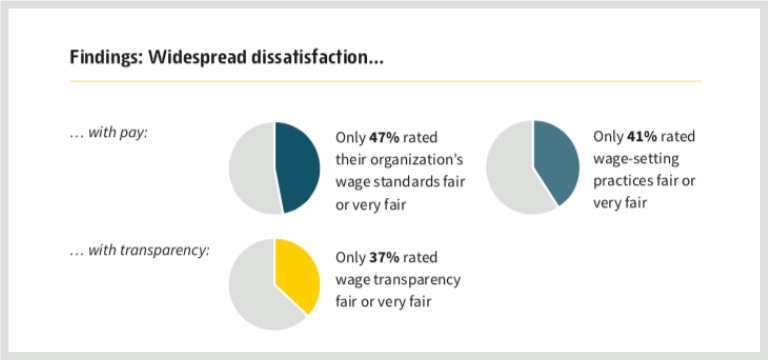Fund Wellness Opportunities to Help Eliminate Burnout in Nonprofits


Exhaustion, low pay, and poor benefits for those working to improve their communities and mobilize others are issues that grantmakers — especially those practicing social change philanthropy — can help eradicate.
In addition to providing funding for health benefits and paid leave, funders should think more creatively and be more intentional about supporting the emotional, mental, and physical wellbeing of those who choose to advocate for underserved communities.
After conducting a survey of the perceived fairness of human resources practices at nonprofits across the country, Class Action, an organization dedicated to ending classism, confirmed in their 2020 Staffing the Mission project report that a majority of respondents were unhappy with wage standards and transparency. Further, many “linked poor job quality to racial inequity in the nonprofit sector.”
While some respondents had more positive opinions on benefits and hiring processes, overall, low-quality nonprofit jobs were a concern for those who worked in the sector.

The Staffing the Mission report focused on what funders can do to eliminate burnout in nonprofit jobs. The survey also led to recommendations for nonprofits to improve job quality, even with a minimal budget. The report challenged organizations to do the following:
Move toward needs-based compensation, instead of relying on prevailing wage standards,
Follow a five-step process for setting pay, and
These recommendations can be implemented with minimal challenges and force grant-seeking organizations to be accountable.
Over the next five years, Staffing the Mission will implement a program plan with the goal of working in collaboration with mission-aligned organizations committed to providing grantees funding for living wages and good benefits. Part of the plan includes funder certification for those who support quality nonprofit jobs at their grantee organizations along with an annual award for those nonprofits able to improve job quality despite financial constraints.
Further, Class Action will bring these like-minded organizations together to develop a set of benchmarks for best practices that will allow funders to self-assess. This tool can support other funders looking to be more intentional in their giving while exploring their ability to support the full costs of their grantees’ projects.
Finally, Staffing the Mission plans to create workshops, consulting, and an online toolkit to provide resources to funders and nonprofits looking to improve HR practices.
Staffing the Mission’s recommendations for funders, as noted in the graphic below, are geared toward large foundations and donors; however, the addition of a small special opportunity fund, for example, to award wellness grants to community-based, social justice organizations is an option, especially for funders who traditionally make strategic but smaller grant awards.

Funded wellness opportunities can support nonprofit workers who are currently facing a crisis when it comes to work-life balance. Not only are they challenged with low pay and minimal benefits, but they also experience significant burnout from working excessive hours and being denied paid leave to engage in self-care.
In reviewing these survey findings and considering my own experience in the field, I understand that workers tend to quit nonprofit jobs for more lucrative corporate positions or for part-time gigs that offer greater flexibility and remote opportunities. A special opportunity fund for wellness activities and programs can help improve low-quality jobs.
Funders are encouraged to implement Staffing the Mission’s initial recommendations, but here are additional simple steps funders can take to support workers experiencing nonprofit burnout:
Survey current grantees to determine which organizations offer wellness programs and discover what wellness looks like to them (e.g., a mindful meditation workshop, a series of confidential healing conversations).
Develop a special opportunity fund and request current grantees apply for funding to implement a COVID-safe wellness activity or program.
Identify organizations providing wellness and respite opportunities and share this resource list with your grantees.
These steps are a great start to investing in talent who are actively spearheading community change. The need for workplace health in the nonprofit sector is critically important to successful community-building and advocacy tactics that will help underserved individuals and families most in need.
This type of funding supported me while working in civic engagement. During the rigorous election and Census season of 2020, I managed voter and census education campaigns when a funder, Groundswell Fund, invited me to participate in a workshop for organizers. The training focused on creating social engagement activities and allowed attendees to participate in wellness opportunities during a tumultuous political cycle.
The support allowed me to gain new skills, share information, listen, and unload stress related to working long hours, managing staff, recruiting volunteers, and organizing events. Many of the organizers in the workshop, which lasted for several weeks, participated in meditative wellness activities and also shared their stories, their challenges, and what they were fighting for during the election season. The stakes were high, and there were tears of pain from some.
Hearing those stories — and the ability to share own — was therapeutic. I was a part of a safe space where I didn’t feel alone because others could relate to my plight. This perk was an added wellness benefit funded by the grantmaker.
Funders who award smaller grants may not be able to cover health benefits, but a wellness grant could provide grantees an option for their staff to take time to replenish and prepare for the next major project. This small gesture can help employees feel valued which may support increased job satisfaction. An incentive such as a wellness activity signals to employees that their organization acknowledges the necessity for benefits that meet staff members’ needs.
Transparency, as noted in the Staffing the Mission report, as well as accountability, is appreciated by nonprofit staff. One nonprofit, CompassPoint, shared with Staffing the Mission that they offer rejuvenation days to staff upon completion of a big project. This benefit encourages staff to practice self-care.
“An incentive such as a wellness activity signals to employees that their organization acknowledges the necessity for benefits that meet staff members’ needs.”
CompassPoint is a nonprofit based in California that helps leaders, nonprofit organizations, and movements committed to social justice realize their full power. The organization developed “Compensation Reimagined” to help eliminate the inequities in their resource distribution process. Not only did the team in 2016 explore various compensation models of other organizations, they formed a peer-led equity panel to determine appropriate salaries for staff.
Further, CompassPoint went above and beyond by reviewing their benefits package and found that offering flexible benefits — the opportunity to tailor benefits such as health insurance coverage, tuition benefits, or childcare assistance to each employee according to their needs and preferences — better met the needs of their employees. While the organization can’t offer large raises, the perk of rejuvenation days shows the staff that they are appreciated and that the company realizes that self-care after completion of a major project is important.
Grantmakers should consider funding wellness opportunities like rejuvenation days and healing conversations, especially if they are unable to fund traditional benefits. This strategy will improve employee morale which leads to employee efficiency and effectiveness.
Staffing the Mission is conducting a new survey now, co-sponsored by Fund the People, a national campaign to maximize investment in the nonprofit workforce. I encourage all funders to take the survey.
Survey responses will help the field develop best practices around nonprofit living wages and personnel policies. Let us know what steps you’ve taken to eliminate low-quality nonprofit jobs. Do your grantees offer a comprehensive benefits package that includes medical, dental, vision, disability, long-term care, life insurance, a matching retirement plan, paid time off, etc.? Are your grantees given the opportunity to take time to celebrate accomplishments and recharge?
Your responses will help our advisory committee further understand the current challenges funders face when discussing the living wage movement. We look forward to sharing the results of this survey later this summer.
